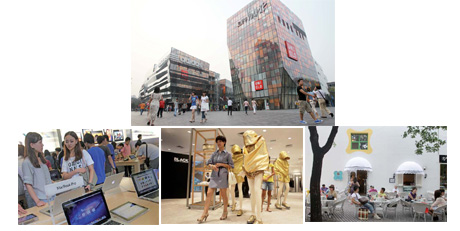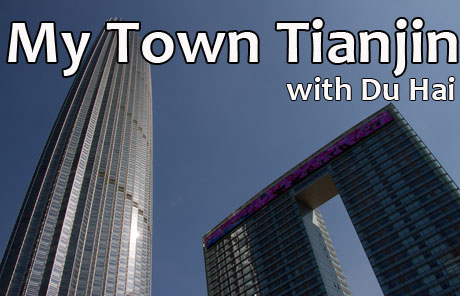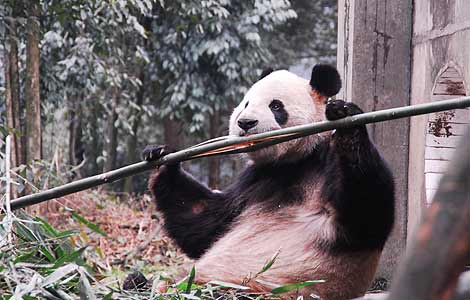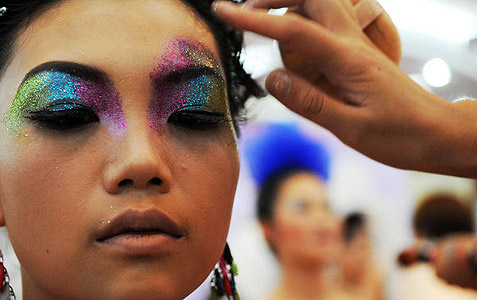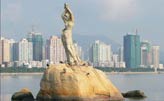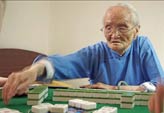Melting pot of fashion
Updated: 2011-09-09 08:40
By Xiao Xiangyi (China Daily)
|
|||||||||
|
Clockwise from top: Pedestrians in Sanlitun Village, which has attracted many international brands to open their outlets. People relaxing at an outdoor French cafe. There are more than 30 restaurants and bars that offer a choice of Chinese and international cuisine in the Village. A retail store in the Village. Business is buzzing in the Village's Apple Store. Photos by Wang Jing / China Daily |
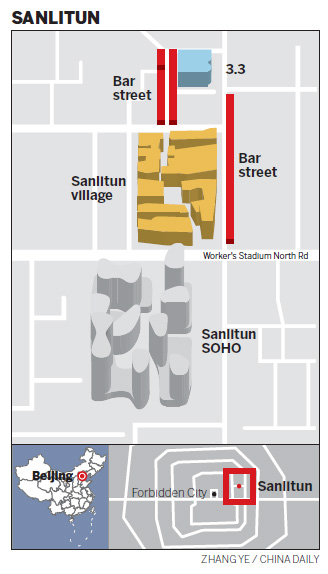
Big brands find fertile hunting, grazing grounds in trendy, modern Sanlitun
Returning to Beijing last month after a decade away, Swedish businessman Bjorn Wahlstrom could not believe the transformation in Sanlitun, his erstwhile favorite watering hole. Shielding his eyes from the brilliant sunlight reflecting off the glass wall of a sprawling red and orange building, as he searched for his favorite haunts from the past, he says, "everything has changed". Wahlstrom's reflection is well founded. Much like the caterpillar that transforms into a beautiful butterfly, Sanlitun has metamorphosed from being just an area filled with bars (some seedy) to a glitzy and myriad world of entertainment that attracts most of the trendy, fashionable and creative urbanites in Beijing.
Standing tall on the Sanlitun landscape is the high priest of fashion represented by the multi-storied Village complex that has shops, restaurants and cinemas within its fold. It was also the first project on the mainland set up by Hong Kong-based Swire Properties in 2008, just before the Beijing Olympics. Today there are several other complexes in the area like Sanlitun Soho, but the Village, figuratively at least, towers above all.
For a sprawling city like Beijing, it is often difficult to pinpoint where the real economic buzz is happening. But Sanlitun is undoubtedly where one can find a truly internationalized and fashionable commercial zone.
The region is home to more than 79 foreign embassies and it is the entertainment destination in the capital. The Entertainment Avenue around the Workers' Stadium is a top draw for foreigners and Chinese who want to be a part of the veritable melting point of entertainment and fashion.
Lu Yanan, editor of Fashion L'Officiel, a joint venture between Chinese publisher Fashion and France's L'Officiel, says Sanlitun represents what is modern and fashionable in Beijing.
"It is sure to find a place in any of the city's publicity films. On the streets of Beijing it is not uncommon for foreigners to seek directions to Sanlitun," she says.
"It is the coolest place in China, where the trendy and the young gather. Sanlitun really has done a good job to grab eyeballs, but still cannot be compared to global fashion capitals like Paris, New York and Tokyo. But it certainly has the potential to be one in the future," says Zhang Chi, a Chinese fashion designer. Buoyed by the growth prospects, several Chinese fashion designers like Zhang are now planning studios in Sanlitun.
This year's Government Work Report of the Chaoyang district describes Sanlitun as a "fashionable and stylish consumption" area. City officials are working on a plan to set up an international shopping center in Chaoyang district, with Sanlitun among the destinations being considered, says an official from the Chaoyang government on condition of anonymity.
"In terms of new products, Sanlitun lags other destinations like Milan or New York. But at least in China, it is the most avant-garde. What we need is time to catch up," says the official.
The Village also has the most distinctive architecture style among all commercial centers in Beijing, or even in China. The lead designer of the project was noted Japanese architect Kengo Kuma, who also designed the Japanese headquarters of the LVMH Group. Kuma adopted a unique "open-plan" design for the Village by creating a set of retail buildings interspersed with alleys, courtyards, lanes and squares.
"It is an avant-garde masterpiece. The layout, the colors and the materials are all impressive," says Pascal Babey, principal architect of a Swiss firm's China branch.
There is no doubt that the architecture and layout are proving to be top draws. Buoyed by the commercial prospects several big brands have located their flagship stores or concept stores here.
One of the big companies that has successfully capitalized on Sanlitun's growing economic prowess is global tech major Apple Inc that has its first China store in the Village.
"Apple retail stores are the places where people come to learn, to experience and to have fun. We prefer the places near where customers come to try and buy our products and to get support," Ron Johnson, Apple's senior vice-president of retail, said in 2008 when the store was opened.
Johnson said Sanlitun was exactly such a venue. "We think our Beijing customers will love what the Apple Store in Sanlitun has to offer."
Apart from Apple, many other young and energetic international fashion brands like Adidas, UNIQLO and CK Jeans all have outlets in the Village. The complex also has an eight-screen cinema complex and is home to more than 30 restaurants and bars that offer a choice of Chinese and international cuisine.
"Sanlitun is fashionable yet not picky and at the same time tolerant," says the 33-year-old French entrepreneur Nicholas Raoul Bourles, who is one of the several foreigners who run restaurants and cafes. Bourles sells French snack crepes in his alfresco cafe, Crepanini, and is trying to introduce French food culture to the Chinese.
"When I came to China five years ago, Sanlitun was the first place my friend had shown me. I knew then that this was the place where everybody loved to come to," he says. He thought a few European-style snacks and a cup of coffee might be perfect supplements to people's shopping experiences here.
"The happiest thing every day is to see the plates come back empty to the kitchen. That means my customers enjoy the food," says Bourles.
Alvin Kong, general manager of Swire Properties' mainland portfolio, says his company has three decades of experience in developing and managing world-class retail complexes in Hong Kong, and he believes the success of a retail establishment lies with its trade mix, overall experience and professional management.
An exceptional retail environment and a good understanding of retailers' business needs have attracted many retailers to open their concept and flagship stores in the Village, he says.
The north section of Sanlitun Village offers a sophisticated shopping environment with flagship designer stores, such as Hong Kong fashion brand I.T., the fashion house Balenciaga under the umbrella of French group PPR, Balmain founded by French designer Pierre Alexandre Claudius Balmain in 1945, and French design house Lanvin. Besides, a trade mix of boutique restaurants, alfresco cafes and art galleries offers a unique Sanlitun experience.
Kong believes a good trade mix takes much more than just putting all the brands together. "We are very selective in the brands that we feature. Shoppers will be delighted to patronize if they find the brands complementary. We also want to create a total experience including interesting food and beverages - with some being the only or the first in Beijing - for visitors ready for a hearty feast."
"In our market research, we rate highly the internationalized, fashionable and creative characteristics of Sanlitun," says Guo Mingxia, deputy manager of 3.3 Shopping Center, which sells only haute couture or extraordinary costumes with unique design. "We are actually trying to boost the revival of the costume culture in Sanlitun, as the area used to be known as a costume bazaar 20 years ago."
Guo says today more than 30 percent of the customers who come to 3.3 are from the fashion field or entertainment circles. "3.3 will continue to be focused on creativity and design. We've already seen a trend of budding business of haute couture. But it is still a niche market," she says.
"Some of the designs are purely Chinese in style, but have caught the fancy of foreign customers," says Guo. "That's why we encourage our designers to absorb Chinese traditional and cultural elements into their works."
Sanlitun is also a popular destination for movie settings. Some of the scenes of many cosmopolitan films like last year's hit romantic comedy Go Lala Go were shot here. It is also no surprise to see scores of trendily dressed young women who make perfect pictures of fashion crisscrossing the various alleys and yards.
"Sometimes you will see movie stars or singers moving around in Sanlitun, but without the mad flock of fans around them. Their privacy is well protected here," says Guo.
But for most Beijingers, the fashionable hot spot originated from a bar street clustered with plush karaoke bars, generic hotel casinos and modernized opium dens. The bar street, to the east of Sanlitun Village and 3.3, is still there and is likely to last forever, but without any of these infamous attractions.
"Wine culture is the first notable charm of Sanlitun civilization. The bars there are not going to vanish because it is the genesis of Beijing's nightlife. Other entertainment items such as dining, shopping and performances are all follow-ups of the wine culture," says fashion magazine editor Lu.
Like other rising commercial centers in China, retailers in Sanlitun too are feeling the pinch due to the labor shortage.
"The biggest challenge is in finding the right kind of employees. It is probably because of the counter-urbanization. People in the other regions do not want to come to Beijing anymore. There is also a sea change in work culture. People no longer want to be a waiter or waitress. In the West, it is just a job, but in China people think of employment as a matter of social status," says Catalin T. Ichim, a restaurateur in the Village.
(China Daily 09/09/2011 page12)
